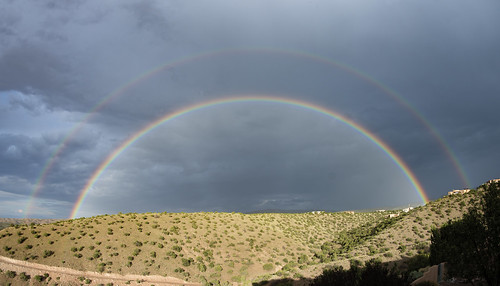Ask the meteorologist: How does a double rainbow form?
Double Rainbow #DoubleRainbow

Question: What does a double rainbow mean? Thank you. — Pat
Answer: The principal indication given by a double bow is that the raindrops that are refracting and reflecting sunlight are of medium to large size, rather than being very small or tiny droplets.
The larger droplets produce narrower and brighter bows, making the secondary bow more visible than it would be with smaller drops.
The primary bow, produced by light rays reflected once within the drops, occurs along a circle that is about a 42-degree angle from the center of that circle, while the secondary bow, produced by light rays that reflect twice within the drops, occurs at about a 51-degrees angle. One thing to notice when you see a double bow is that due to the second reflection the colors are reversed – the primary bow is red on the outside edge, while the secondary is red on the inside.The secondary bow is a good deal fainter than the primary, so that when the drops are small and the bow is faint, it may not be noticed at all. There’s a lot of great information about rainbows, along with diagrams explaining how they form and photographic examples of the many different forms, in the Atmospheric Optics blog.
Question: I have seen rainbows. I have photographed double and even triple rainbows. Is a quadruple rainbow possible? — Bill Dinwiddie
Answer: Most of us see primary and secondary rainbows from time to time, and rather frequently we see “supernumerary” bows that are part of these two, especially just inside the primary bow. Few of us will ever see any higher order bows involving three to six internal reflections, as they are much fainter than those involving one and two reflections, and are also located in parts of the sky that make them even harder to see or photograph.
Third and fourth order bows are seen in the direction of the sun and are therefore usually completely obscured by the brightness of the sky in that direction, while the fifth and sixth order bows are even fainter, and are largely overlain by the much brighter primary and secondary bows. Nonetheless, third and fourth order rainbows have been photographed. Atmospheric Optics has reported on these, too, including how to identify and photograph them.